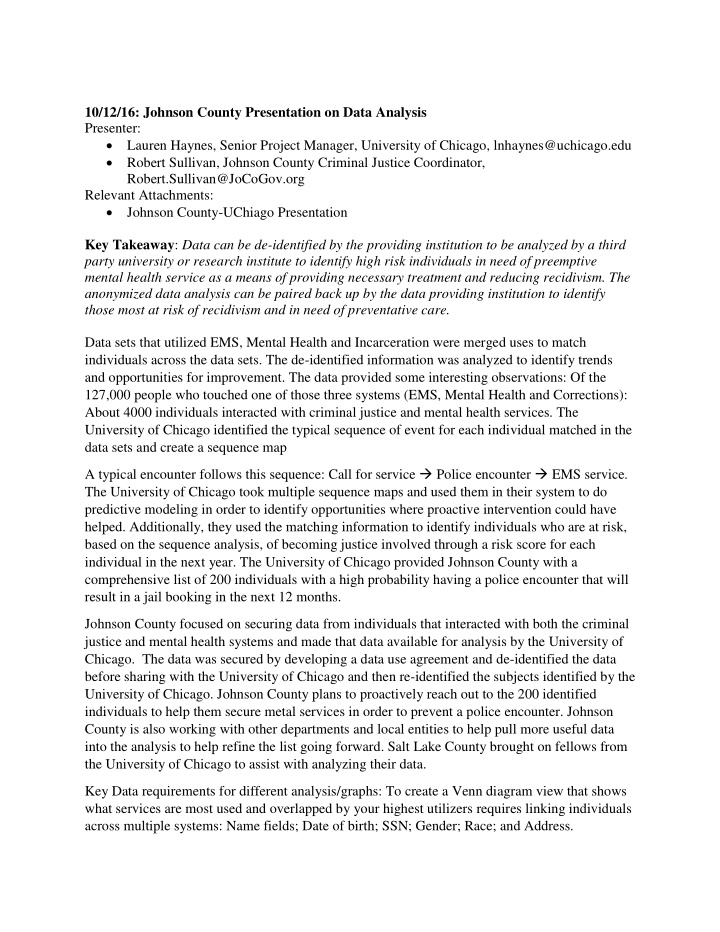



10/12/16: Johnson County Presentation on Data Analysis Presenter: Lauren Haynes, Senior Project Manager, University of Chicago, lnhaynes@uchicago.edu Robert Sullivan, Johnson County Criminal Justice Coordinator, Robert.Sullivan@JoCoGov.org Relevant Attachments: Johnson County-UChiago Presentation Key Takeaway : Data can be de-identified by the providing institution to be analyzed by a third party university or research institute to identify high risk individuals in need of preemptive mental health service as a means of providing necessary treatment and reducing recidivism. The anonymized data analysis can be paired back up by the data providing institution to identify those most at risk of recidivism and in need of preventative care. Data sets that utilized EMS, Mental Health and Incarceration were merged uses to match individuals across the data sets. The de-identified information was analyzed to identify trends and opportunities for improvement. The data provided some interesting observations: Of the 127,000 people who touched one of those three systems (EMS, Mental Health and Corrections): About 4000 individuals interacted with criminal justice and mental health services. The University of Chicago identified the typical sequence of event for each individual matched in the data sets and create a sequence map A typical encounter follows this sequence: Call for service Police encounter EMS service. The University of Chicago took multiple sequence maps and used them in their system to do predictive modeling in order to identify opportunities where proactive intervention could have helped. Additionally, they used the matching information to identify individuals who are at risk, based on the sequence analysis, of becoming justice involved through a risk score for each individual in the next year. The University of Chicago provided Johnson County with a comprehensive list of 200 individuals with a high probability having a police encounter that will result in a jail booking in the next 12 months. Johnson County focused on securing data from individuals that interacted with both the criminal justice and mental health systems and made that data available for analysis by the University of Chicago. The data was secured by developing a data use agreement and de-identified the data before sharing with the University of Chicago and then re-identified the subjects identified by the University of Chicago. Johnson County plans to proactively reach out to the 200 identified individuals to help them secure metal services in order to prevent a police encounter. Johnson County is also working with other departments and local entities to help pull more useful data into the analysis to help refine the list going forward. Salt Lake County brought on fellows from the University of Chicago to assist with analyzing their data. Key Data requirements for different analysis/graphs: To create a Venn diagram view that shows what services are most used and overlapped by your highest utilizers requires linking individuals across multiple systems: Name fields; Date of birth; SSN; Gender; Race; and Address.
To determine Across-silo frequencies the University of Chicago analyzed data on: ● One record per interaction ● Interaction type ● Date of interaction ● Duration of interaction ● Requires linking/matching from Venn diagram Sequencing ● Crucial to incorporate both start and stop dates of service/booking ● Note distinction between case management start/stop and interaction start/stop ● Documented reason of interaction end is valuable (good behavior, program drop out, administrative reasons, death) Predictive analytics ● All available data from each silo ● We used over 300 indicators for each individual that were generated from the richness of the datasets of each silo: ○ Bail amounts ○ Type of therapy ○ Number of therapists ○ EMS primary impression ● Several (>3) years of history for all silos ● Existing baselines (thresholds) used to identify super-utilizer Q & A: Q. It would be great to hear about how Robert got marginal jail costs? A. They wanted to use the most conservative estimates possible. They relied on the disposable items that inmates use when they are detained in the jail. They used a number from the Jail accountant. Q. Could you explain the 52% precision rate? A. This means that of the list of the 200 people who were identified through the data in the 2015 data and comparing the 2016 data that showed which of those 200 people were booked into jail, 52% of them were actually booked in jail in 2016. This translated to 104 of the 200 people identified being booked into jail in 2016
Q. How cooperative did you find jail administrators to be and what role did they play in compiling the necessary data? A. Johnson County is fortunate to have a fully integrated information management system, which includes their justice information management system. In SLCO, they do not have a fully integrated data system, so they do have a challenge in matching data points across different systems. They have a good relationship with their jail administrators, and got a lot of help from the University of Chicago fellows to set up a system that is able to string data across the various data systems.
Recommend
More recommend